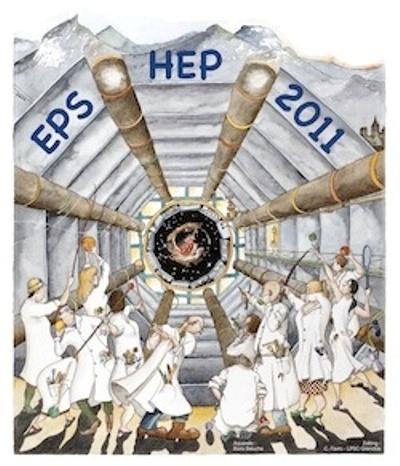
After a year of operation colliding protons at the highest energies ever achieved, scientists working on the ATLAS experiment at the CERN LHC laboratory in Geneva, Switzerland, are releasing breathtaking results that extend and expand our understanding of matter and its interactions. The LHC creates the hottest conditions ever achieved in a lab, reaching energy densities that existed a trillionth of a second after the universe was born in the big bang. This is the epoch when pure energy gained mass and became matter in the early universe, and understanding this transition is a fundamental goal of particle physics. With the enormous number of seminal new results being presented at the Europhysics Conference on High Energy Physics in Grenoble, France, this week, we are on the cusp of breakthroughs in our understanding of the origin and fate of the universe. More than 150 Canadian scientists, about half students, lead international teams investigating the ATLAS data and pushing our knowledge into new territory.
"It is incredibly exciting to know that we are finally closing in on the Higgs - but the LHC is just at the beginning of what we expect to be a very long career, so despite having already waited so many years, we can afford the luxury of patience. If the present hints are confirmed, we will know the answer very soon," said TRIUMF scientist Isabel Trigger. "The present dataset already shows some intriguing hints---although not statistically significant. With more data, a clearer picture will emerge in time," added Oliver Stelzer-Chilton, another TRIUMF scientist working on the ATLAS experiment.
The LHC has performed better in 2011 than even the optimistic expectations. "So far we've collected as much data as was planned for the whole of 2011 and that's already a great achievement for the LHC," said CERN's Director General Rolf Heuer. "While it's still too early for the biggest discoveries, the experiments are already accumulating interesting results."
"Discovery or exclusion of the Higgs particle, as predicted by the Standard Model of Particle Physics, is getting ever closer," said CERN's Director for Research and Scientific Computing, Sergio Bertolucci. "Both occurrences will be great news for physics, the former allowing us to start detailed study of the Higgs particle, the latter being the first proof of the incompleteness of the Standard Model, requiring new phenomena to be happening within the reach of the LHC."
"Canadians can be particularly proud of the achievements of our students, research fellows and faculty, leading to the fantastic scope and breadth of the ATLAS results being released this week" said Robert McPherson from the University of Victoria and Institute of Particle Physics, Spokesperson of the Canadians working on ATLAS at the LHC. "Canadians lead efforts both pinning down the interactions of known particles like the top quark, and also searching for the new physics our theories demand such as the Higgs Boson and Supersymmetry that should be accessible at the LHC."
Members of the TRIUMF group have played leading roles in several ATLAS searches for exotic new particles in the first inverse femtobarn of data, most of which have now set limits well in excess of those set at Fermilab's Tevatron. In addition to the searches for new particles, group members also participate in Standard Model analyses, looking at the very large sample of W and Z bosons and top quarks collected by ATLAS and checking that existing models are able to explain all that we can see with this remarkably good detector and rich dataset. The lead TRIUMF scientists are Anadi Canepa, Oliver Stelzer-Chilton, Reda Tafirout, and Isabel Trigger; Isabel is also deputy leader of the TRIUMF particle-physics group.
Simon Viel, a UBC graduate student working with ATLAS at TRIUMF, said, "It is very exciting to be part of this amazing international effort in particle physics, especially now that discoveries are at hand. The atmosphere at the EPS conference is vibrant with the anticipation from physicists worldwide." Simon is one of the lead analyzers in the search for heavier cousins of the Nobel-prize-winning particle called the Z; he is selecting events with tell-tale patterns of muons to look for these potential new heavy neutral gauge bosons.
Ian Nugent, a post-doctoral fellow at TRIUMF, is an expert in what is called "missing energy" analysis; that is, studying events where the energy visible in decaying particles is less than the initial collision energy, suggesting that undetected particles (such as neutrinos or something else more exotic) have carried away some of the energy. Dominique Fortin is a post-doctoral fellow at TRIUMF and convenes an international working group that looks for exotic decays that involve leptons (electrons, muons, or taus) in association with other particles.
Canadian groups made important contributions to the ATLAS experiment and to the LHC itself. The TRIUMF lab in Vancouver hosts one of the ten "Tier-1" data analysis centres that streams ATLAS data in real-time for physics analysis. TRIUMF also built key parts of the LHC. Canadian groups from the University of Alberta, University of British Columbia, Carleton University, McGill University, University of Montreal, University of Regina, Simon Fraser University, University of Toronto, University of Victoria and York University, as well as the TRIUMF laboratory, built and operate critical components of ATLAS. Canadian scientists, including about 80 graduate students, 30 postdoctoral research fellows and 40 faculty members, continue to lead ATLAS physics analysis efforts.
--From a TRIUMF and ATLAS-Canada press release
